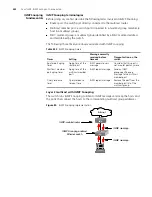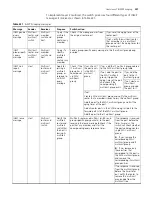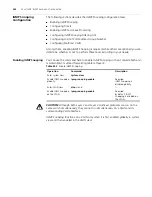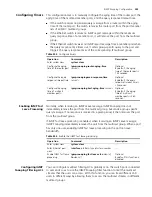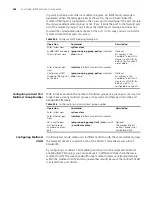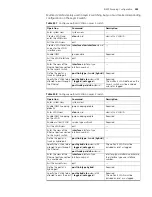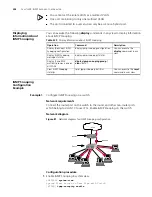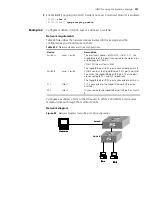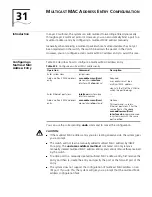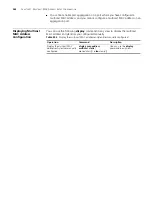
31
M
ULTICAST
MAC A
DDRESS
E
NTRY
C
ONFIGURATION
Introduction
In Layer 2 multicast, the system can add multicast forwarding entries dynamically
through Layer 2 multicast protocol. However, you can also statically bind a port to a
multicast address entry by configuring a multicast MAC address manually.
Generally, when receiving a multicast packet whose multicast address has not yet
been registered on the switch, the switch broadcasts the packet in the VLAN.
However, you can configure a static multicast MAC address entry to avoid this case.
Configuring a
Multicast MAC
Address Entry
Table 232 describes how to configure a multicast MAC address entry.
You can use the corresponding
undo
command to cancel the configuration.
CAUTION:
■
If the multicast MAC address entry you are creating already exists, the system gives
you a prompt.
■
The switch will not learn a manually added multicast MAC address by IGMP
Snooping. The
undo mac
-
address
multicast
command can only remove
manually created multicast MAC address entries and cannot remove those learned
by the switch.
■
To add a port to a manually created multicast MAC address entry, first remove the
entry, and then re-create the entry and specify the port as the forward port of the
entry.
■
The system does not support the configuration of multicast MAC address on an
IRF port. If you do this, the system will give you a prompt that the multicast MAC
address configuration fails.
Table 232
Configure a multicast MAC address entry
Operation
Command
Description
Enter system view
system-view
—
Add a multicast MAC address
entry
mac-address multicast
mac-address
interface
interface-list
vlan
vlan-id
Required
mac-address
must be a
multicast MAC address.
vlan-id
is the ID of the VLAN to
which the port belongs.
Enter Ethernet port view
interface
interface-type
interface-number
—
Add a multicast MAC address
entry.
mac-address multicast
mac-address
vlan
vlan-id
Optional
This command is used in
Ethernet port view. It has the
same effect as the above
mac-address multicast
interface
vlan
command used
in system view with the same
port specified.
Summary of Contents for 4200G 12-Port
Page 10: ...8 CONTENTS...
Page 14: ...4 ABOUT THIS GUIDE...
Page 46: ...32 CHAPTER 5 LOGGING IN THROUGH WEB BASED NETWORK MANAGEMENT SYSTEM...
Page 48: ...34 CHAPTER 6 LOGGING IN THROUGH NMS...
Page 60: ...46 CHAPTER 9 VLAN CONFIGURATION...
Page 64: ...50 CHAPTER 10 MANAGEMENT VLAN CONFIGURATION...
Page 80: ...66 CHAPTER 13 GVRP CONFIGURATION...
Page 98: ...84 CHAPTER 15 LINK AGGREGATION CONFIGURATION...
Page 112: ...98 CHAPTER 18 MAC ADDRESS TABLE MANAGEMENT...
Page 126: ...112 CHAPTER 19 LOGGING IN THROUGH TELNET...
Page 162: ...148 CHAPTER 20 MSTP CONFIGURATION...
Page 274: ...260 CHAPTER 29 IGMP SNOOPING CONFIGURATION...
Page 276: ...262 CHAPTER 30 ROUTING PORT JOIN TO MULTICAST GROUP CONFIGURATION...
Page 298: ...284 CHAPTER 33 SNMP CONFIGURATION...
Page 304: ...290 CHAPTER 34 RMON CONFIGURATION...
Page 338: ...324 CHAPTER 36 SSH TERMINAL SERVICES...
Page 356: ...342 CHAPTER 38 FTP AND TFTP CONFIGURATION...
Page 365: ...Information Center Configuration Example 351 S4200G terminal logging...
Page 366: ...352 CHAPTER 39 INFORMATION CENTER...
Page 378: ...364 CHAPTER 40 BOOTROM AND HOST SOFTWARE LOADING...
Page 384: ...370 CHAPTER 41 Basic System Configuration and Debugging...
Page 388: ...374 CHAPTER 43 NETWORK CONNECTIVITY TEST...
Page 406: ...392 CHAPTER 45 CONFIGURATION OF NEWLY ADDED CLUSTER FUNCTIONS...


